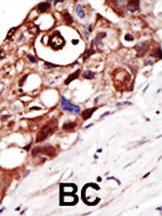GPI8 Antibody (N-term)
Purified Rabbit Polyclonal Antibody (Pab)
- SPECIFICATION
- CITATIONS: 1
- PROTOCOLS
- BACKGROUND

Application
| WB, IHC-P, E |
|---|---|
| Primary Accession | Q92643 |
| Other Accession | Q4KRV1, Q9CXY9, Q3MHZ7 |
| Reactivity | Human |
| Predicted | Bovine, Mouse, Pig |
| Host | Rabbit |
| Clonality | Polyclonal |
| Isotype | Rabbit IgG |
| Calculated MW | 45252 Da |
| Antigen Region | 37-68 aa |
| Gene ID | 10026 |
|---|---|
| Other Names | GPI-anchor transamidase, GPI transamidase, 3---, GPI8 homolog, hGPI8, Phosphatidylinositol-glycan biosynthesis class K protein, PIG-K, PIGK, GPI8 |
| Target/Specificity | This GPI8 antibody is generated from rabbits immunized with a KLH conjugated synthetic peptide between 37-68 amino acids from the N-terminal region of human GPI8. |
| Dilution | WB~~1:1000 IHC-P~~1:50~100 E~~Use at an assay dependent concentration. |
| Format | Purified polyclonal antibody supplied in PBS with 0.09% (W/V) sodium azide. This antibody is prepared by Saturated Ammonium Sulfate (SAS) precipitation followed by dialysis against PBS. |
| Storage | Maintain refrigerated at 2-8°C for up to 2 weeks. For long term storage store at -20°C in small aliquots to prevent freeze-thaw cycles. |
| Precautions | GPI8 Antibody (N-term) is for research use only and not for use in diagnostic or therapeutic procedures. |
| Name | PIGK (HGNC:8965) |
|---|---|
| Function | Catalytic subunit of the glycosylphosphatidylinositol-anchor (GPI-anchor) transamidase (GPI-T) complex that catalyzes the formation of the linkage between a proprotein and a GPI-anchor and participates in GPI anchored protein biosynthesis (PubMed:10793132, PubMed:11483512, PubMed:12582175, PubMed:34576938, PubMed:35165458, PubMed:35551457, PubMed:37684232, PubMed:9356492). Recognizes diverse proproteins at a C-terminal signal peptide (CSP) region that lacks consensus sequence and replaces it with a GPI-anchor via a transamidation reaction (PubMed:35165458, PubMed:35551457, PubMed:37684232). Transamidation catalysis reaction follows a two-phase mechanism (PubMed:37684232). In the acyl-enzyme phase, the carbonyl group of the proproteins's omega- site undergoes a nucleophilic attack forming an enzyme-substrate thioester bond (PubMed:37684232). Followed by a general acid catalysis that allows CSP releasing, regenerating the carbonyl, and forming the acyl-enzyme intermediate (PubMed:37684232). In the GPI-anchor attachment phase, the amino group of the GPI-anchor's ethanolamine phosphate, the one on third mannose (EtNP3), mediates a nucleophilic attack on the carbonyl of the acyl-enzyme intermediate, replacing the CSP, allowing GPI-anchor attachment to the omega-residue, therefore forming the product and freeing the enzyme (PubMed:37684232). |
| Cellular Location | Endoplasmic reticulum membrane; Single-pass type I membrane protein |

Provided below are standard protocols that you may find useful for product applications.
Background
GPI8 is a member of the cysteine protease family C13 that is involved in glycosylphosphatidylinositol (GPI)-anchor biosynthesis. The GPI-anchor is a glycolipid found on many blood cells and serves to anchor proteins to the cell surface. This protein is a member of the multisubunit enzyme, GPI transamidase and is thought to be its enzymatic component. GPI transamidase mediates GPI anchoring in the endoplasmic reticulum, by catalyzing the transfer of fully assembled GPI units to proteins.
References
Ohishi, K., et al., J. Biol. Chem. 278(16):13959-13967 (2003). Vainauskas, S., et al., J. Biol. Chem. 277(34):30535-30542 (2002). Ohishi, K., et al., EMBO J. 20(15):4088-4098 (2001). Meyer, U., et al., Biochemistry 39(12):3461-3471 (2000). Yu, J., et al., Proc. Natl. Acad. Sci. U.S.A. 94(23):12580-12585 (1997).
If you have used an Abcepta product and would like to share how it has performed, please click on the "Submit Review" button and provide the requested information. Our staff will examine and post your review and contact you if needed.
If you have any additional inquiries please email technical services at tech@abcepta.com.














 Foundational characteristics of cancer include proliferation, angiogenesis, migration, evasion of apoptosis, and cellular immortality. Find key markers for these cellular processes and antibodies to detect them.
Foundational characteristics of cancer include proliferation, angiogenesis, migration, evasion of apoptosis, and cellular immortality. Find key markers for these cellular processes and antibodies to detect them. The SUMOplot™ Analysis Program predicts and scores sumoylation sites in your protein. SUMOylation is a post-translational modification involved in various cellular processes, such as nuclear-cytosolic transport, transcriptional regulation, apoptosis, protein stability, response to stress, and progression through the cell cycle.
The SUMOplot™ Analysis Program predicts and scores sumoylation sites in your protein. SUMOylation is a post-translational modification involved in various cellular processes, such as nuclear-cytosolic transport, transcriptional regulation, apoptosis, protein stability, response to stress, and progression through the cell cycle. The Autophagy Receptor Motif Plotter predicts and scores autophagy receptor binding sites in your protein. Identifying proteins connected to this pathway is critical to understanding the role of autophagy in physiological as well as pathological processes such as development, differentiation, neurodegenerative diseases, stress, infection, and cancer.
The Autophagy Receptor Motif Plotter predicts and scores autophagy receptor binding sites in your protein. Identifying proteins connected to this pathway is critical to understanding the role of autophagy in physiological as well as pathological processes such as development, differentiation, neurodegenerative diseases, stress, infection, and cancer.


